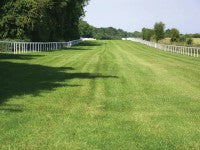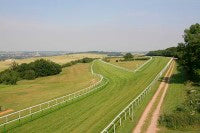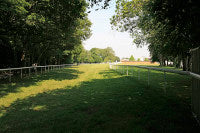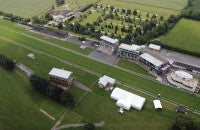Flat out at Salisbury!
 The horseracing heritage at Salisbury is one of the longest-standing in the country, dating back to the 1500s when the first meeting on this historic downland site was recorded.
The horseracing heritage at Salisbury is one of the longest-standing in the country, dating back to the 1500s when the first meeting on this historic downland site was recorded.
The flat-racing course sprawls across 48 acres of the Pembroke estate, sitting next door to the Salisbury & South Wilts Golf Club, and enjoying a 40-year lease from estate-owner, The Earl of Pembroke, whose seat is the magnificent Palladian-style Wilton House nearby.
Although independent of one another, the two sporting venues collaborate in friendly fashion when the need arises.
In an era when managers are assuming power at an ever earlier age, the disclosure by Clerk of the Course, Jeremy Martin, that he is still only 38, and that he had already squeezed in a hefty amount of experience before moving to Salisbury, comes as something of a revelation.
Clearly, his career has moved ahead at the gallop rather than a canter and his cheery demeanour and 'easy' management style shouts success at every twist and turn.
 Also estates manager of the course, Jeremy came on board nearly a decade ago, in January 2001, arriving from Brighton Racecourse, where he had even, by then, held the clerk's post for three years.
Also estates manager of the course, Jeremy came on board nearly a decade ago, in January 2001, arriving from Brighton Racecourse, where he had even, by then, held the clerk's post for three years.
Now in his ninth season at Salisbury, Jeremy has spent no fewer than eleven years as a clerk of the course. The old cliché 'It's in his blood' springs to mind, and with good reason, as he has worked in racing since leaving school.
"I'd always been interested in racing as a young man and completed a three-year diploma in horse management upon leaving school," he explains. "To be a clerk of the course was my burning ambition though, and I've been fortunate in my career to make the most of the opportunities I've had, which meant I could enter the position of clerk of the course while still at a relatively young age - coming to the post at twenty-seven when at Brighton."
While working for Northern Racing, and completing his clerk training at Brighton, Jeremy gained invaluable experience clerking on race days at tracks such as Uttoxeter, Newcastle and Chepstow. When the post as clerk and manager at Salisbury fell vacant, it was a position he was not about to miss out on. "The course is one well regarded by those in the racing industry," he says, "and the move was a step up that I wanted to take."
The going's not always good when running and managing a successful racecourse, Jeremy concedes, and the recession has impacted on the business over the last two years, he admits, but Salisbury is proving to be resilient in tough times.
He places a priority on avoiding the need to cancel race days, even more so recently, because of the attendant loss of revenue. "We can lose anything from £30,000 to £60,000 if a meeting is cancelled," he reveals.
Ensuring profitability through economic turbulence can be challenging, especially when, understandably, the safety of the horses must take priority. Preparing the course appropriately to meet these needs requires nothing less than a deep knowledge of the particulars and peculiarities of the course, Jeremy maintains, and that comes with experience and insight.
 "You have to understand to what degree rainfall affects the course, how much irrigation is needed before a race day and where the problem areas are on the course," he says. "Something that can only be learned over time."
"You have to understand to what degree rainfall affects the course, how much irrigation is needed before a race day and where the problem areas are on the course," he says. "Something that can only be learned over time."
Following several wet years and a few cancelled race days, Salisbury has put in place measures to help prevent such financially painful downtime recurring.
Ably assisted in his ambitions by head groundsman, Richard Hayter, Jeremy can benefit from the thirty years experience of his right hand man, who, still only 45, has spent his whole working life at Salisbury, joining part-time in 1978 before taking up a full-time post in 1982.
Racing at the course follows a five and a half month calendar, from the start of May to mid-October, and includes sixteen race meetings, following a pattern of weekday afternoons and weekend fixtures that attracts crowds varying from 2,000 to 7,500.
"Our opening fixture tends to be the busiest of our entire calendar," says Jeremy, "and is held on the first Sunday in May, the week before the May bank holiday, kicking the season off with a bang."
The 2009 season saw Salisbury attract 55,000 racegoers through the gates, a figure almost identical to the previous year. Jeremy's delighted: "This time, twelve months ago, we had no idea what to expect with the banking meltdown and the recession taking a grip over the whole country. In hindsight, we have to be very satisfied with how the last six months have gone."
 Although corporate activity is down 30% year on year, attendances have held up well with racegoers continuing to spend well while on site, he adds. "The spend in the bars and snack areas have hardly been affected, whereas some of the betting commissions have fallen by 10% this last year."
Although corporate activity is down 30% year on year, attendances have held up well with racegoers continuing to spend well while on site, he adds. "The spend in the bars and snack areas have hardly been affected, whereas some of the betting commissions have fallen by 10% this last year."
"Generally though, I've noticed that when people go out, they tend to want to make the most of their time, so customers have not been cutting back too much."
Grounds surely for looking ahead with optimism? "For the most part we are generally optimistic about the future. If 2010 was a mirror of 2009, then I would be very happy."
The last two years have seen no cancellations, and all race days fulfilled, but Jeremy always takes a considered view. "We definitely err on the side of caution. If there are any risks at all, we won't race. If the ground is heavy or if there are any areas that could cause a problem, we simply do not risk it. The health of the horses is paramount."
Salisbury's spotless racing record recently is, in part, due to the impact of wise investments in measures that have potentially saved the course thousands of pounds in lost revenue. Taking pride of place among them is the Blotter. "We've only had to use the machine a couple of times since the purchase, but it has already saved us at least one race, so we've recouped our outlay already," Jeremy states.
Jeremy purchased the £22,000 machine in spring 2008 on a three-year payback plan and it first came into its own that summer. "The rain bucketed down two days before a Saturday race meeting in the middle of July, which followed an intensive period of three other meets," Jeremy recalls. "Grounds generally struggle with the wet when they have been raced on intensely over a short period but, with the aid of the Blotter, we managed to prepare the course for racing with a good surface."
 Salisbury Racecourse is an undulating one, built on a well-structured shallow, sandy clay loam on chalk. Given the increasingly unpredictable weather in recent years, especially the spells of torrential rain through summer months, temporary ponding has become an occupational hazard - one confined to the Wiltshire site.
Salisbury Racecourse is an undulating one, built on a well-structured shallow, sandy clay loam on chalk. Given the increasingly unpredictable weather in recent years, especially the spells of torrential rain through summer months, temporary ponding has become an occupational hazard - one confined to the Wiltshire site.
"We can no longer afford to wait for water to disperse like we might have done in the past," declares Jeremy, "and can now go straight out there with the Blotter and put the control back into our hands, so we do not have to be so dependant on the weather to help us out - which it rarely does anyway."
He first heard about the Blotter's benefits during the particularly wet summer of 2007 when York Racecourse hired one. "The story of its success was relayed to us after being told that it had saved a race meeting. We decided to bring one down for a demo after having lost a few meetings between 2005 and 2007. It was a pricey purchase, but worth it as we can lose so much when a race meet is cancelled."
A couple of areas of the course are prone to becoming heavy and wet, Jeremy explains - in the dip at two and a half furlongs and behind the seven furlong start - particularly towards the end of the season. Ensuring that surface water doesn't sit there for long has been a major concern for the grounds team.
"When you lose a race meeting, particularly when you abandon on the day of racing, you still have to honour your commitments to suppliers and contractors, which will mean paying them regardless," he says, adding firmly: "It would only be extremely bad luck for us to lose a race meeting now, and torrential rain would have to fall on previously very soft ground, which would make the Blotter unable to cope in those conditions."
 Shifting water off a racing surface is a key factor in managing any racecourse, another equally crucial one is to ensure the appropriate quantity is retained to create optimum race conditions to.
Shifting water off a racing surface is a key factor in managing any racecourse, another equally crucial one is to ensure the appropriate quantity is retained to create optimum race conditions to.
Richard Hayter is of the firm belief that irrigation should be done only when it's needed, and stresses that an 'old hand' can almost divine when that is. "The trick is not to let the grounds get too hard. If we have a dry and hot forecast in the run-up to a race, we'll often start the watering process ten days beforehand to give the course four or five applications. Ultimately, the weather dictates, so we make sure we stay on top of the forecasts."
Salisbury pumps water from its borehole to an above-ground 35,000-gallon capacity reservoir using the system that contractors MJ Abbott installed in 2001.
"Over ten years ago we decided to invest in a new irrigation system as ours was simply not up to the job," says Jeremy. "We had a combination of tow line watering and a boom which really wasn't very good, so we decided to buy a Briggs system in 2004 and also alter some of the hydrant points at the same time."
Using the Briggs irrigation boom, the team have the capacity to apply 10mm of water on the course in two, seven-hour, working days. It had taken up to a week, says Richard. "We could water in a day if we wanted to, especially in the summer when there's more daylight and when irrigation is usually more important," adds Jeremy.
 Salisbury's evolving watering practices have changed the nature of the original downland grass species over the years. The course currently comprises 97% ryegrass with a small percentage of Yorkshire fog, annual meadow grass, narrow leaf fescue and bent.
Salisbury's evolving watering practices have changed the nature of the original downland grass species over the years. The course currently comprises 97% ryegrass with a small percentage of Yorkshire fog, annual meadow grass, narrow leaf fescue and bent.
A wider variety of seed is used for some jobs, notably as part of post-race repairs to the course. "Our divot mixes depend on what our suppliers Rigby Taylor recommend," says Richard - "we usually go for their own specific racecourse mix."
"We are lucky to have a particularly thick sward, which alleviates the need for much overseeding. We will try to hollow tine at the same time as we vertidrain though - which we planned to do in November if conditions allowed, which usually means no damper than good ground."
Jeremy flicks through the latest report on the course from Salisbury's agronomists - Professional Sportsturf Design - to reveal that "The soil is of a slightly acidic nature". "All racecourses are required to have such a report prepared annually under British Horse Racing Authority regulations," he says. Given the value of the horses racing on any given day, that's not surprising.
"Every racecourse runs differently though," Jeremy adds, "so, knowing the course inside out and discovering its weak spots and its individual characteristics, is not only crucial to good maintenance practice but also helps keep groundstaff on their toes in the search for alternative methods of tackling persistent problem areas."
"We have three or four that tend to cause us most problems with damage - down the hill between five and four furlongs is most common as that's where the horses dig their toes in. The day after racing, we have to tread back in the holes and repair any damage."
 Good post-race practice ensures the team brings the course back up to its best ready for racing once more. "We have a team from the estate that comes and helps with the after-race repairs - the worst of the holes are filled back in and I'll then check it a few days later, railing off any areas that haven't recovered properly," Jeremy explains.
Good post-race practice ensures the team brings the course back up to its best ready for racing once more. "We have a team from the estate that comes and helps with the after-race repairs - the worst of the holes are filled back in and I'll then check it a few days later, railing off any areas that haven't recovered properly," Jeremy explains.
The more intensive racing programme, between June and July, when fixtures are often held every six days, demands that additional help, he adds. "Our four permanent grounds staff simply could not handle all the work themselves, so we have to recruit casuals over the summer to do some of the smaller jobs."
Richard continues with a smile: "Often, all of us have to be prepared to lend a hand during the very busy periods. Even Jeremy will sometimes have to help with a bit of treading back."
Keeping the course in fine fettle over intensive race periods can throw up some big challenges, but the biggest of all, says Richard, is to be prepared for anything on race day. Experience comes to his aid because time has taught him to pay heed to the early indicators. "Often, if we have a quiet morning, you know it's going to be hectic in the afternoon and vice versa," he reveals.
Being prepared for all eventualities is one thing but, sometimes, something crops up to frustrate any preparation. Five years ago, a racehorse called Nick the Silver caused mayhem when he broke through the plastic rail, ran down through the woods, joined the nearby Salisbury to Blandford road, galloped along the road two miles into the city and was found munching the grass in someone's front garden.
"It could have been quite a long night looking for a horse in Salisbury," jokes Jeremy, "yet the story does emphasise one of the most important aspects of the job - incident management."
Blessed (cursed he might contend) with one of the tightest bends in British horseracing, Jeremy knows, all to well, the importance of keeping on top of potential problem spots on course.
"We've found the best way to combat the bend is to water the ground well, so it is on the soft side of good, so that the horses can get their hooves in," explains Jeremy. "There's nothing worse than having firm ground with either lush or slightly damp grass."
Despite slip-ups by horses in the past, the days of such concerns seem to be behind them, and jockeys now voice their confidence in what was once seen as a major hazard.
Commenting in the Racing Post - the industry's 'Bible' - a jockey said that it was an example of how best a tight bend should be prepared for racing. "If there's even the slightest whiff of moisture in the air now, we sand using a topdresser," Jeremy says, "hiring a machine to ensure the job only takes ten minutes to complete."
The smooth running of a race meeting comes down to teamwork to bring everything together in time, he believes, and that doesn't just apply to Salisbury's groundstaff. "Lots of rules and safety measures apply to horse-racing now. The regulations state that you have to have two doctors and two paramedic ambulances on site before racing starts."
"It's very important that everyone turns up - from the officials to the treaders-in. If not, problems result. Luckily, we've only lost one horse this year, but it's crucial we maintain incident management at the highest possible standards."
Even factors such as the evenness of colour on the course is vital, as young horses, especially, will jump anything of a different hue - the reason that Richard lays down grass cuttings over sandy areas.
Different sports can live happily side by side, but the potential pitfalls of a golf course abutting a racecourse might seem like a disaster waiting to happen.
When the original nine-hole golf course was laid out, centuries after the estate witnessed its first racing action, agreement was reached, perhaps albeit grudgingly by members of the golf club, that play was out of bounds on the eve of race days, race days themselves and the day after.
A number of holes lie adjacent to the racecourse and wayward balls would often land on the racing turf, presenting potential dangers to the horses if a galloping hoof flicked one up.
It was only a matter of time before the golf club decided to build another course to ensure members and visitors could enjoy golf whenever they liked. The nine-hole original course, dubbed the Bibury, is a challenge for any golfer and commands wonderful views, scenery and settings. It has its own separate membership, and the restrictions on play still apply, but the uninterrupted game is now enjoyed by those joining the 18-hole companion course (constructed in two, nine-hole, phases).
A fair number of golf balls find their way on to the racecourse, says Jeremy. "There must be thousands of them pushed into the ground. When we stripped away a small hump from the field a few years back we found hundreds of them in just a twenty square metre area. Luckily, we've never had a jockey complain that a horse has kicked up a ball."
"The health of the horses has to be our biggest concern on race days. Trainers and jockeys need to be confident that the ground we prepare is in good condition."
One of Salisbury's major initiatives to keep the turf as healthy as possible is to regularly move the running rail. This sounds like hard graft for the team, over and above the usual duties, but Jeremy knows how effective it has proved to be.
"The ground that's raced on must never be allowed to become too damaged. That way, it can recover more quickly and save us time and money," he states. And the success of the method has received high acclaim - the BHA inspectorate applauding the team for offering the freshest ground possible for horseracing. It's an accolade that Jeremy is fiercely proud of.
"The introduction of plastic railing in recent years has made this possible," he says. "Before we installed it, we could take as long as a week to connect up the 7.5km of aluminium piping along the straight."
Teamwork is key to Salisbury's success. Jeremy stresses the importance of good team relations in a climate where differing opinions on maintenance can be discussed "freely". "Richard wouldn't necessarily agree with everything I have to say," Jeremy admits, "but I will always listen to his views, as his experience in the job exceeds my own, and he certainly knows his stuff."
Images © Salisbury Racecourse, Trish Steel and Peter Facey
